Determining the Dependence of a Landscape’s Ecological Stability and the Intensity of Erosion during 1990–2018
Abstract
1. Introduction
- Constancy means a minimal change in an ecological system or no change in an ecological system.
- Repetition in cycles defines changes in an ecological system that occur in regular cycles.
- The resistance of an ecological system characterizes the resilience of that ecological system to external influences or minimal changes due to external factors and the preservation of its structure to a certain extent.
- Resiliency means a change in an ecological system due to the action of an external factor and a return to the original state thanks to self-regulatory mechanisms.
- The dynamic balance of a landscape ensures the balance of fluctuations due to changing conditions, which result in a certain stability of the ecological system, which is manifested in its resistance to external disturbances. The opposite of this element is ecological lability.
- Ecological lability is a component without the ability to resist external factors, which consequently does not have the power to return to the original initial state of the ecological system.
- The ecological stability coefficient is the ratio of the relatively stable and relatively unstable elements;
- The ecological stability coefficient is determined on the basis of the acreage of landscape elements, taking into account the ecological significance of a landscape [6]. The connection between ecological stability and soil water erosion differences was defined based on the determination of soil water erosion processes during the years 1990, 2006, 2012, and 2018. The aim of the study was to identify if changes in ecological stability correlate with soil water erosion changes and how the intensity of erosion processes affects ecological stability. Both terms used (ecological stability and soil water erosion) are one of the most frequently analyzed terms in the scientific world because they are directly related to climate change. The sensitivity of soil water erosion can be defined in terms of land use and climate and is one of the most serious environmental degradation risks, negatively affecting the soil’s attributes and functions as well. When we talk about the “degradation” of soil, we generally mean a process that decreases the current or potential capacity of the soil to provide a healthy basis for ecosystem services through human activities. Soil degradation is not only caused by a harsh climate; it can also be caused by poor land management practices and policies. According to Jankauskas (2003) [7], deforestation, a low level of landscape management, and overgrazing are the main reasons for the development of floods, wind, or water erosion. On the other hand, Borrelli (2020) [8] claims that inappropriate agricultural processes are the main reason for the generation of soil or environmental disruptions and that they also represent a major source of greenhouse gas emissions.
- -
- The intensity of soil water erosion, together with ecological stability, was evaluated in order to reflect the relationship between changes in ecological stability and the water erosion of soil;
- -
- A determination of the impact of changes in ecological stability on the intensity of water soil erosion;
- -
- Reflections as to how the landscape changed during the selected years, i.e., 1990–2018, considering that these changes are projected in the degree of the ecological stability of the landscape as well as in the intensity of the erosion processes.
2. Materials and Methods
2.1. Study Area
2.2. Characteristics of the Input Data
2.3. Analyses of Ecological Stability
- -
- A CES < 0.10 indicates territory with maximal disturbance to the natural structures; the basic ecological functions must be intensively and permanently replaced through technical interventions;
- -
- A CES in the range of 0.10–0.30 indicates a territory with intensive use featuring a clear disruption to natural structures;
- -
- A CES in the range of 0.30–1.00 indicates a territory intensively used mainly for agricultural production; a large number of self-regulatory processes cause ecological lability;
- -
- A CES > 1.00 indicates an almost balanced landscape in which the technical objects are relatively in harmony with the natural structures
- CES < 0.30—the poorest landscape structure;
- CES 0.31–0.40—a poor landscape structure;
- CES 0.41–0.50—a low-quality landscape structure;
- CES 0.51–0.60—a moderately high-quality landscape structure;
- CES 0.61–0.70—a medium-quality landscape structure;
- CES 0.71–0.80—a significantly high-quality landscape structure;
- CES > 0.81—the best landscape structure.
- -
- CES < 1.00—predominantly natural landscape elements;
- -
- CES = 1.00—a balanced landscape;
- -
- CES > 1.00—predominantly anthropogenic landscape elements.
- -
- CES 1.00–1.49—a landscape with very low ecological stability;
- -
- CES 1.50–2.49—a landscape with low ecological stability;
- -
- CES 2.50–3.49—a landscape with medium ecological stability;
- -
- CES 3.50–4.49—a landscape with high ecological stability;
- -
- CES 4.50–5.00—a landscape with very high ecological stability.
2.4. CLM Model
2.5. EROSION-3D Model
3. Results
- (a)
- An analysis of the development of ecological stability for the years selected, i.e., 1990, 2006, 2012, and 2018;
- (b)
- A determination of the changes in the landscape in terms of the distribution of individual landscape elements and the extent to which these changes have affected ecological stability and erosion intensity;
- (c)
- An estimation of the relationship between ecological stability and erosion processes, i.e., defining the connection and determining its dependence.
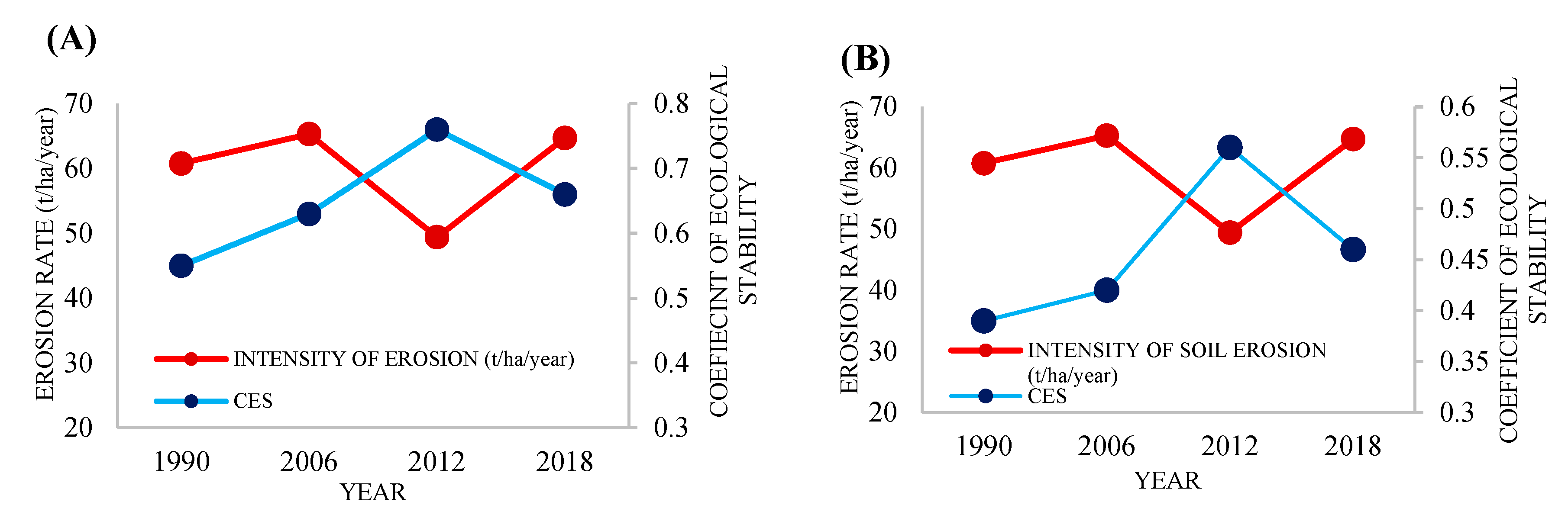
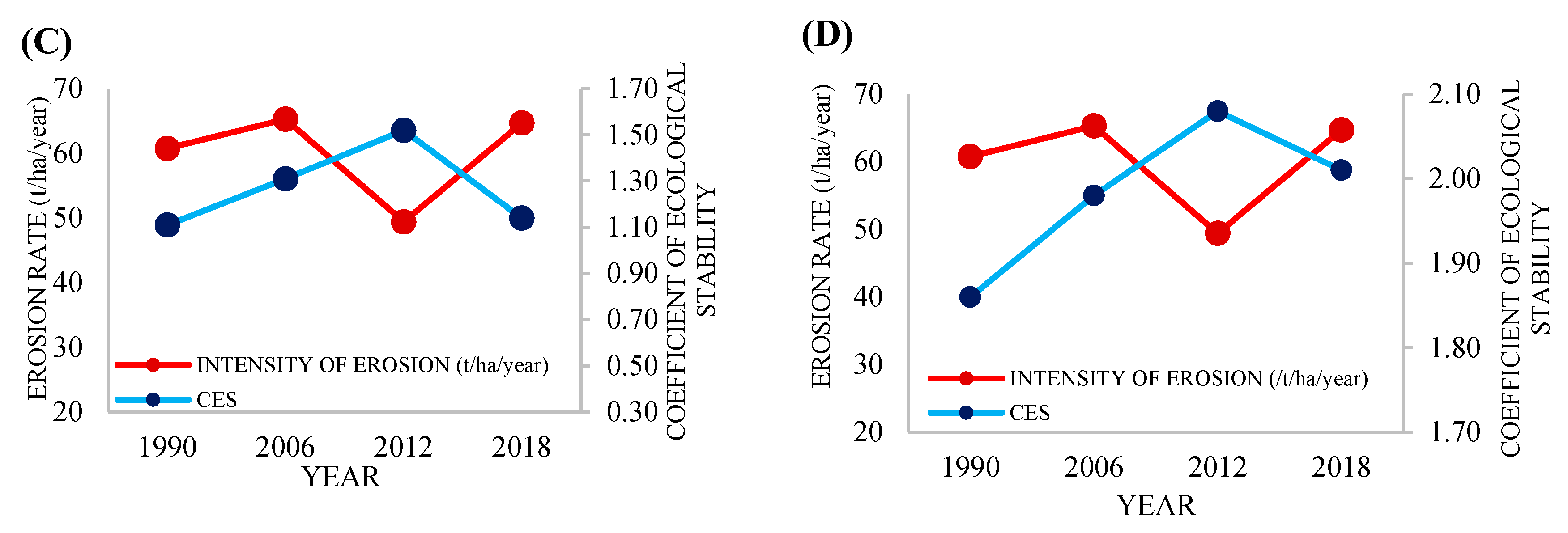
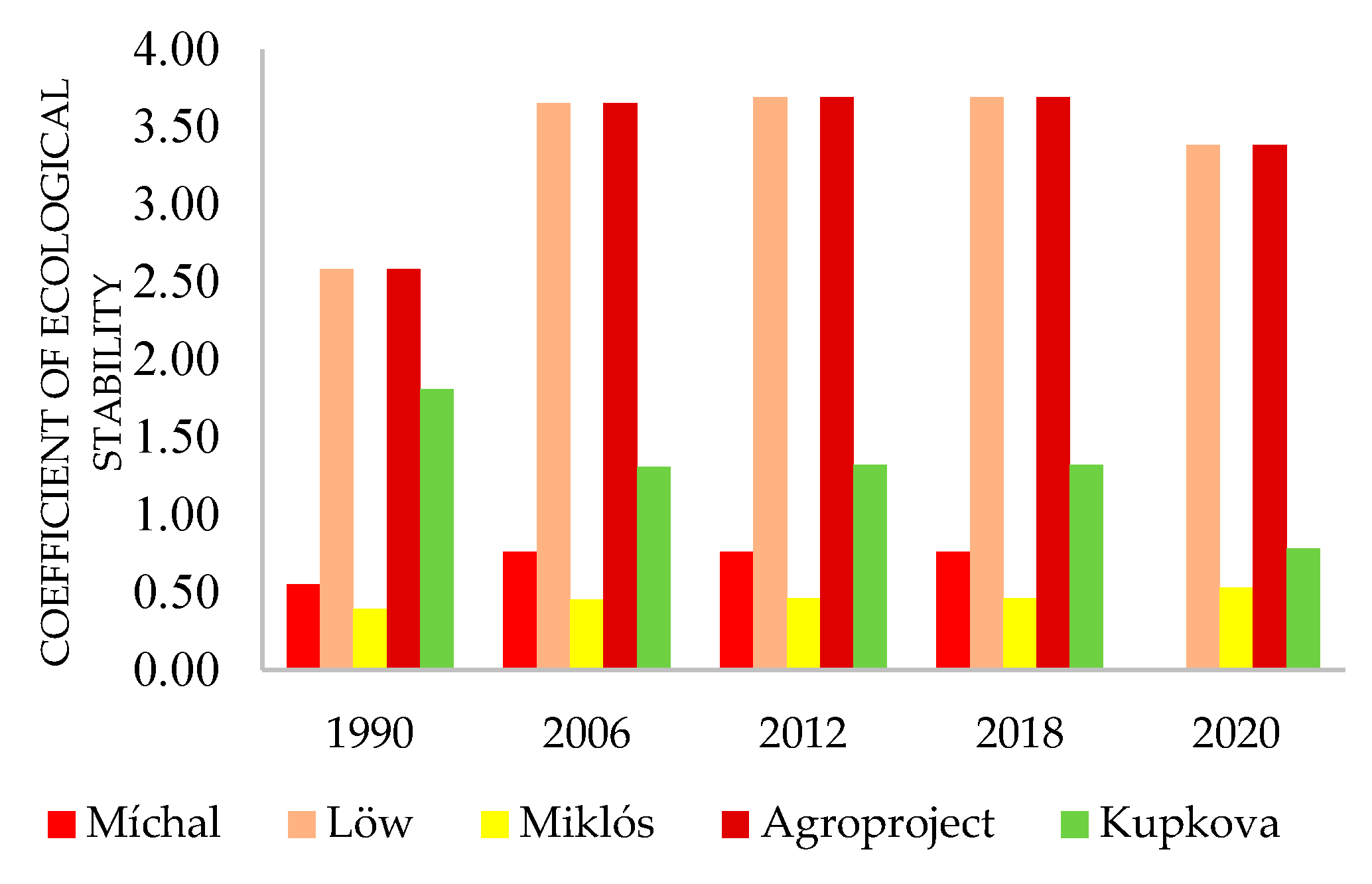
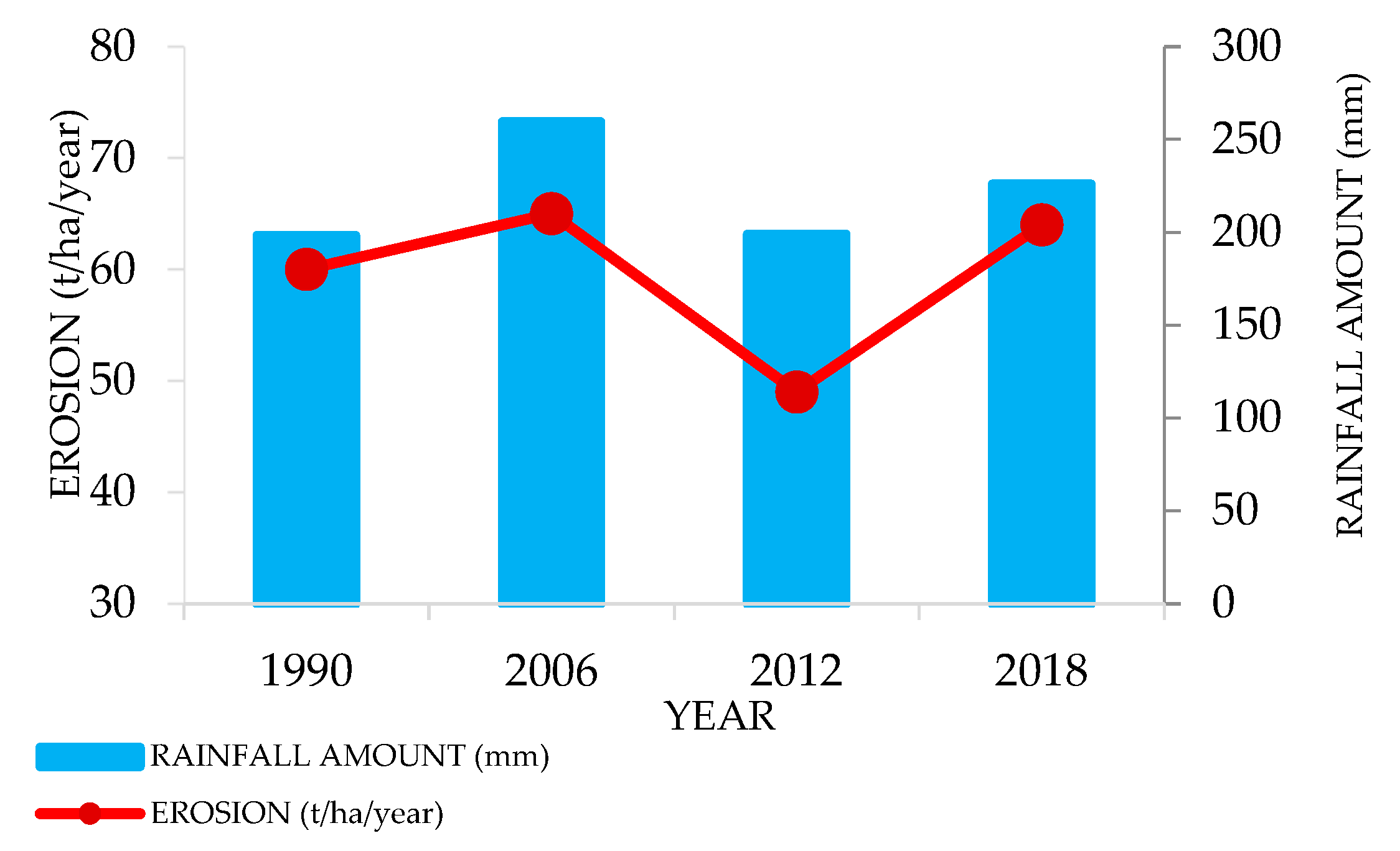
4. Discussion
5. Conclusions
Author Contributions
Funding
Data Availability Statement
Acknowledgments
Conflicts of Interest
References
- White, H.J.; Caplat, P.; Emmerson, M.C.; Yearsley, J.M. Predicting future stability of ecosystem functioning under climate change. Agric. Ecosyst. Environ. 2021, 320, 107600. [Google Scholar] [CrossRef]
- Cerdà, A.; Terol, E.; Daliakopoulos, I.N. Weed cover controls soil and water losses in rainfed olive groves in Sierra de Enguera, eastern Iberian Peninsula. J. Env. Manag. 2021, 290, 112516. [Google Scholar] [CrossRef] [PubMed]
- Izakovičová, Z. Territorial system of stress factors. Environment 2014, 48, 204–208. [Google Scholar]
- Ivan, P. Príklad aplikácie vybraných metodických postupov hodnotenia ekologickej stability krajiny na Slovensku. Acta Environ. Univ. Comen. 2013, 2, 13–18. [Google Scholar]
- Vrábliková, J.; Vráblik, P.; Zoubková, L. Landscape Creation and Protection; Faculty of the Environment, J. E. Purkyně University: Ústí nad Labem, Czech Republic, 2014; p. 150. ISBN 978-80-7414-844-6. [Google Scholar]
- Reháčková, T.; Pauditšová, E. Methodical procedure for determining the coefficient of ecological stability of the landscape. Acta Environ. Univ. Comen. 2007, 15, 26–38. [Google Scholar]
- Jankauskas, B.; Jankauskiene, G. Erosion-preventive crop rotations for landscape ecological stability in upland regions of Lithuania. Agric. Ecosyst. Environ. 2003, 95, 129–142. [Google Scholar] [CrossRef]
- Borrelli, P.; Robinson, D.A.; Panagos, P.; Lugato, E.; Yang, J.E.; Alewell, C.H.; Wuepper, D.; Montanarella, L.; Ballabio, C. Land use and climate change impacts on global soil erosion by water (2015–2070). Proc. Natl. Acad. Sci. USA 2020, 117, 21994–22001. [Google Scholar] [CrossRef]
- Imeson, A.C.; Lavee, H. Soil erosion and climate change: The transect approach and the influence of scale. Geomorphology 1998, 23, 2019–2227. [Google Scholar] [CrossRef]
- Kéfy, S.; Domínguez-garcía, V.; Donohue, I.; Fontaine, C.; Thébault, E.; Dakos, V. Advancing our understanding of ecological stability. Ecol. Lett. 2019, 22, 1349–1356. [Google Scholar] [CrossRef] [PubMed]
- Muchová, Z.; Tárniková, M. Land cover change and its influence on the assessment of the ecological stability. Appl. Ecol. Environ. Res. 2018, 16, 2169–2182. [Google Scholar] [CrossRef]
- Hanušin, J.; Huba, M.; Ira, V. Land use, land management and issues related to sustainability and quality of life in the Myjava River basin. Geogr. Slovaca 2008, 25, 123–143. [Google Scholar]
- Miklós, L. Atlas Krajiny Slovenskej Republiky; 1. vyd; Ministerstvo životného prostredia SR: Bratislava, Slovakia, 2002; p. 342. ISBN 80-88833-27-2. [Google Scholar]
- Míchal, I. Principles of landscape evaluation of the territory. In Architecture and Urbanism; XVI/Z; VEDA SAV: Bratislava, Slovakia, 1982; pp. 65–87. (In Slovak) [Google Scholar]
- Miklós, I. Landscape stability in the ecological general SSR. Environment 1986, 20, 87–93. (In Slovak) [Google Scholar]
- Kupková, L. Landscape data yesterday and today. GEOinfo 2001, 1, 16–19. [Google Scholar]
- Lawrence, D.M.; Fisher, R.A.; Koven, C.D.; Oleson, K.W.; Swenson, S.C.; Bonan, G.; Collier, N.; Ghimire, B.; van Kampenhout, L.; Kennedy, D.; et al. The Community Land Model version 5: Description of new features, benchmarking, and impact of forcing uncertainty. J. Adv. Model. Earth Syst. 2019, 11, 4245–4287. [Google Scholar] [CrossRef]
- Schmidt, J. A mathematical model to simulate rainfall erosion. Catena 1991, 19, 101–109. [Google Scholar]
- Campbell, G.S. Soil physics with basic: Transport models for soil-plant systems. Dev. Soil Sci. 1985, 14, 252–254. [Google Scholar]
- Michael, A. Anwendung des Physikalisch Begründeten Erosionsprognosemodells EROSION 2D/3D-Empirische Ansätze zur Ableitung der Modellparameter. Ph.D. Thesis, Technische Universität Bergakademie Freiberg, Freiberg, Germany, 2000. [Google Scholar]
- Uhrová, J.; Štěpánková, P.; Osičkovám, K. Complex system of natural water retention measures against erosion and flash floods. VTEI 2016, 4, 13–19. [Google Scholar] [CrossRef]
- Zolina, O.; Simmer, C.; Kapala, A.; Shabanov, P.; Becker, P.; Mächel, H.; Gulev, S.; Groisman, P. Precipitation Variability and Extremes in Central Europe: New View from STAMMEX Results. Bull. Am. Met. Soc. 2014, 99, 995–1002. [Google Scholar] [CrossRef]
- Dolák, L.; Řezníčková, L.; Dobrovolný, P.; Štěpánek, P.; Zahradníček, P. Extreme precipitation totals under present and future climatic conditions according to regional climate models. In Climate Change Adaptation Pathways from Molecules to Society, 1st ed.; Vačkář, D., Ed.; Global Change Research Institute, Czech Academy of Sciences: Brno, Czech Republic, 2017; Volume 1, pp. 27–37. [Google Scholar]
- Pašakarnis, G.; Maliene, V. Towards sustainable rural development in Central and Eastern Europe: Applying land consolidation. Land Use Policy 2010, 27, 545–549. [Google Scholar] [CrossRef]
- Nearing, M.A.; Pruski, F.F.; O´neal, M.R. Expected climate change impacts on soil erosion rates: A review. J. Soil Water Conserv. 2004, 59, 43–50. [Google Scholar]
- Sisay, G.; Gessesse, B.; Fürst, C.; Kassie, M.; Kebede, B. Modeling of land use/land cover dynamics using artificial neural network and cellular automata Markov chain algorithms in Goang watershed, Ethiopia. Heliyon 2003, 9, 9. [Google Scholar] [CrossRef] [PubMed]
- Tintaya, F.C.; Vargas, E.P.; Villegas, P.T. Soil loss due to water erosion on semi-arid slopes of the Cairani-Camilaca sub-basin, Peru. Idesia 2022, 40, 7–15. [Google Scholar] [CrossRef]
- Barati, A.; Zhoolideh, M.; Azadi, H.; Lee, J.-H.; Scheffran, J. Interactions of land-use cover and climate change at global level: How to mitigate the environmental risks and warming effects. Ecol. Indic. 2003, 146, 109829. [Google Scholar] [CrossRef]
- Sulaeman, D.; Westhoff, T. The Causes and Effects of Soil Erosion, and How to Prevent It; World Resources Institute: Washington, DC, USA, 2020; p. 4. [Google Scholar]
- Ives, A.R.; Carpenter, S.R. Stability and Diversity of Ecosystems; American Association for the Advancement of Science: Washington, DC, USA, 2007; Volume 317, pp. 58–62. [Google Scholar] [CrossRef]
- Mccann, K.; Hastings, A.G.; Huxel, G. Weak Trophic Interactions and the Balance of Nature. Nature 1998, 395, 794–798. [Google Scholar]
- Pimentel, D.; Kounang, N. Ecology of Soil Erosion in Ecosystems. Ecosystems 1998, 1, 416–426. [Google Scholar] [CrossRef]
- Deng, X.; Du, J. Land Quality: Environmental and Human Health Effects, 2nd ed.; Nriagu, J., Encyclopedia of Environmental Health, Eds.: Elsevier: Amsterdam, The Netherlands, 2011; pp. 9–12. ISBN 9780444639523. [Google Scholar] [CrossRef]
- Sauro, U. Changes in the use of natural resources and human impact in the karst environment of the Venetian Prealps (Italy). Acta Carsologica 2006, 35, 57–63. [Google Scholar] [CrossRef]
- Bogan, M.T.; Boersma, K.S.; Lytle, D.A. Resistance and resilience of invertebrate communities toseasonal and supraseasonal drought in arid-land headwaterstreamt. Freshw. Biol. 2015, 60, 2547–2558. [Google Scholar] [CrossRef]
- Parise, M.; Gunn, J. Natural and Anthropogenic Hazards in Karst Areas: Recognition, Analysis and Mitigation; Special Publications; Geological Society: London, UK, 2007; Volume 279, pp. 1–3. [Google Scholar] [CrossRef]
- Geri, F.; Amici, V.; Rocchini, D. Human activity impact on the heterogeneity of a Mediterranean landscape. Appl. Geogr. 2010, 30, 370–379. [Google Scholar] [CrossRef]
- Guofu, L.; Shengyan, D. Impacts of human activity and natural change on the wetland landscape pattern along the Yellow River in Henan Province. J. Geogr. Sci. 2004, 14, 339–348. [Google Scholar] [CrossRef]
- Fuentes, A.; Baynes-Rock, M. Anthropogenic Landscapes, Human Action and the Process of Co-Construction with other Species: Making Anthromes in the Anthropocene. Land 2017, 6, 15. [Google Scholar] [CrossRef]
- Andriani, G.F.; Walsh, N. An example of the effects of anthropogenic changes on natural environment in the Apulian karst (southern Italy). Environmetal Geol. 2009, 58, 313–325. [Google Scholar] [CrossRef]
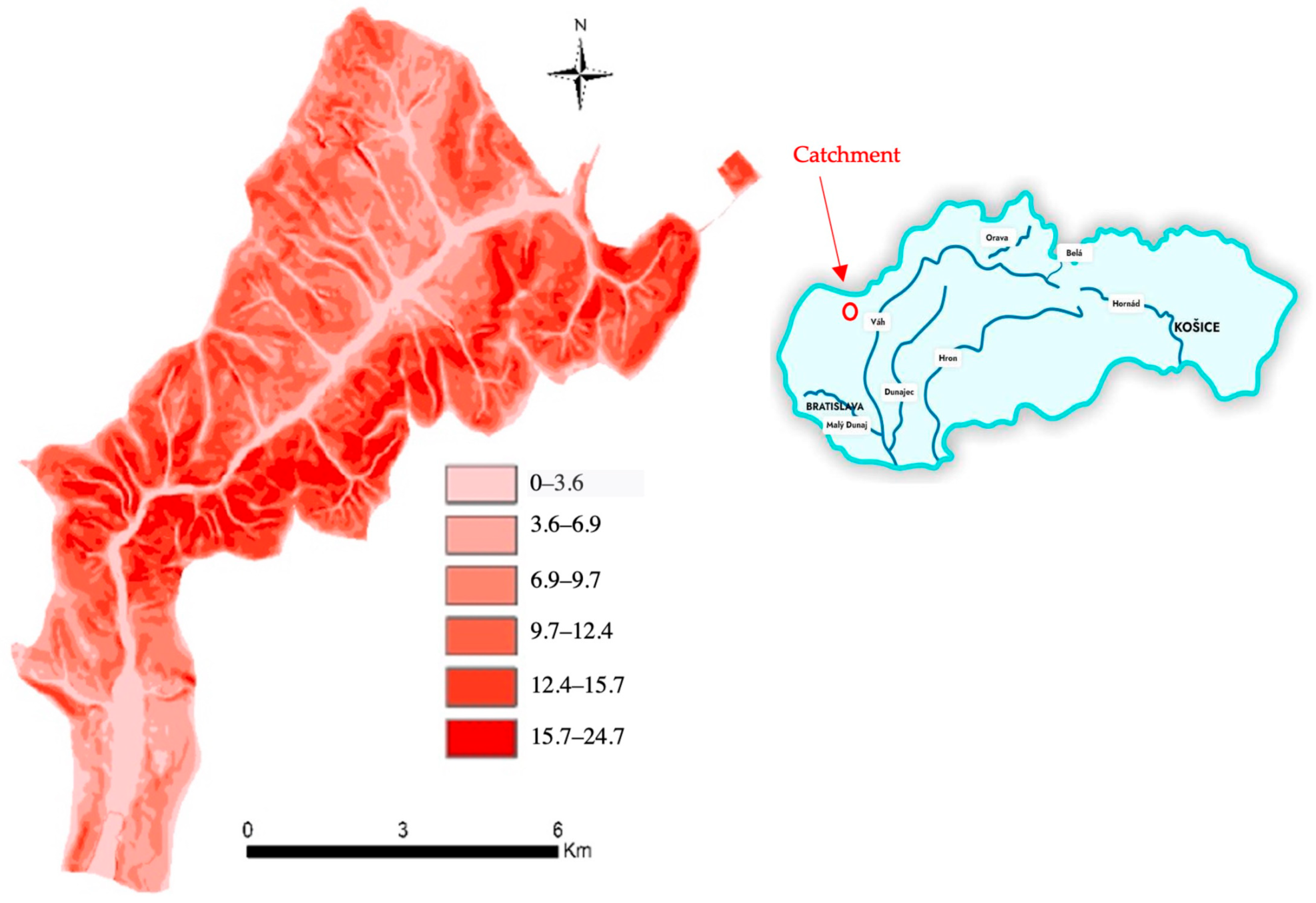

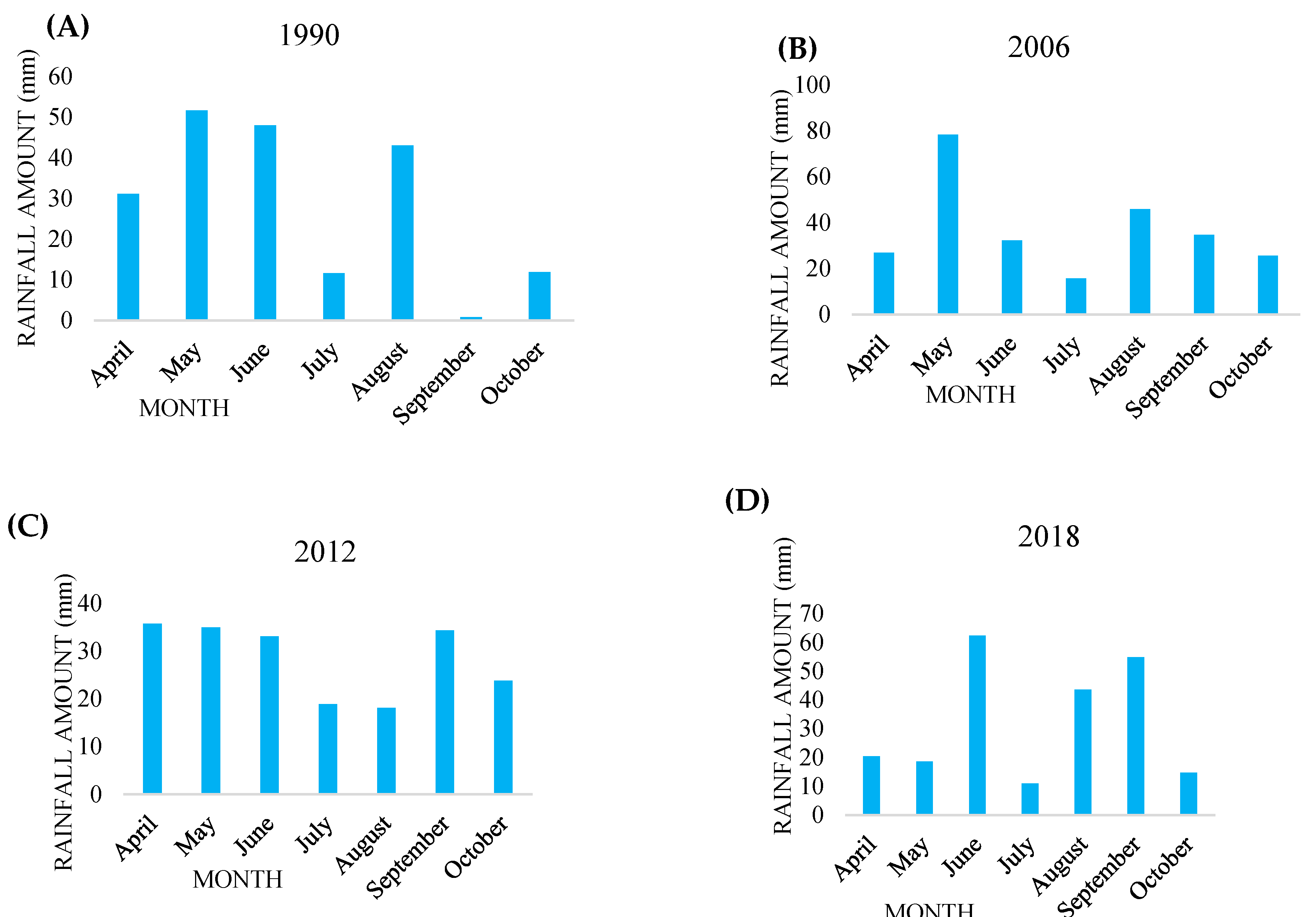
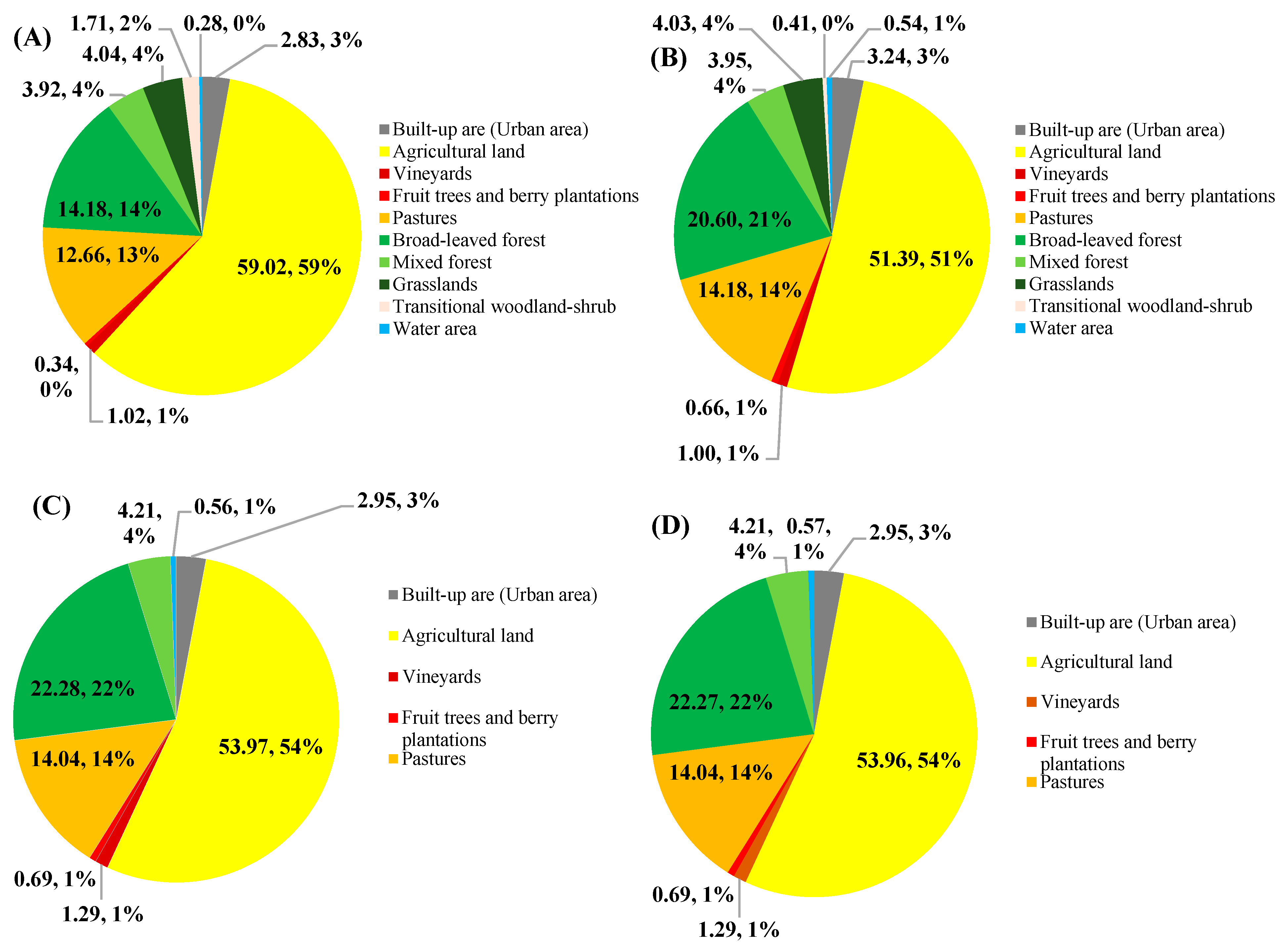
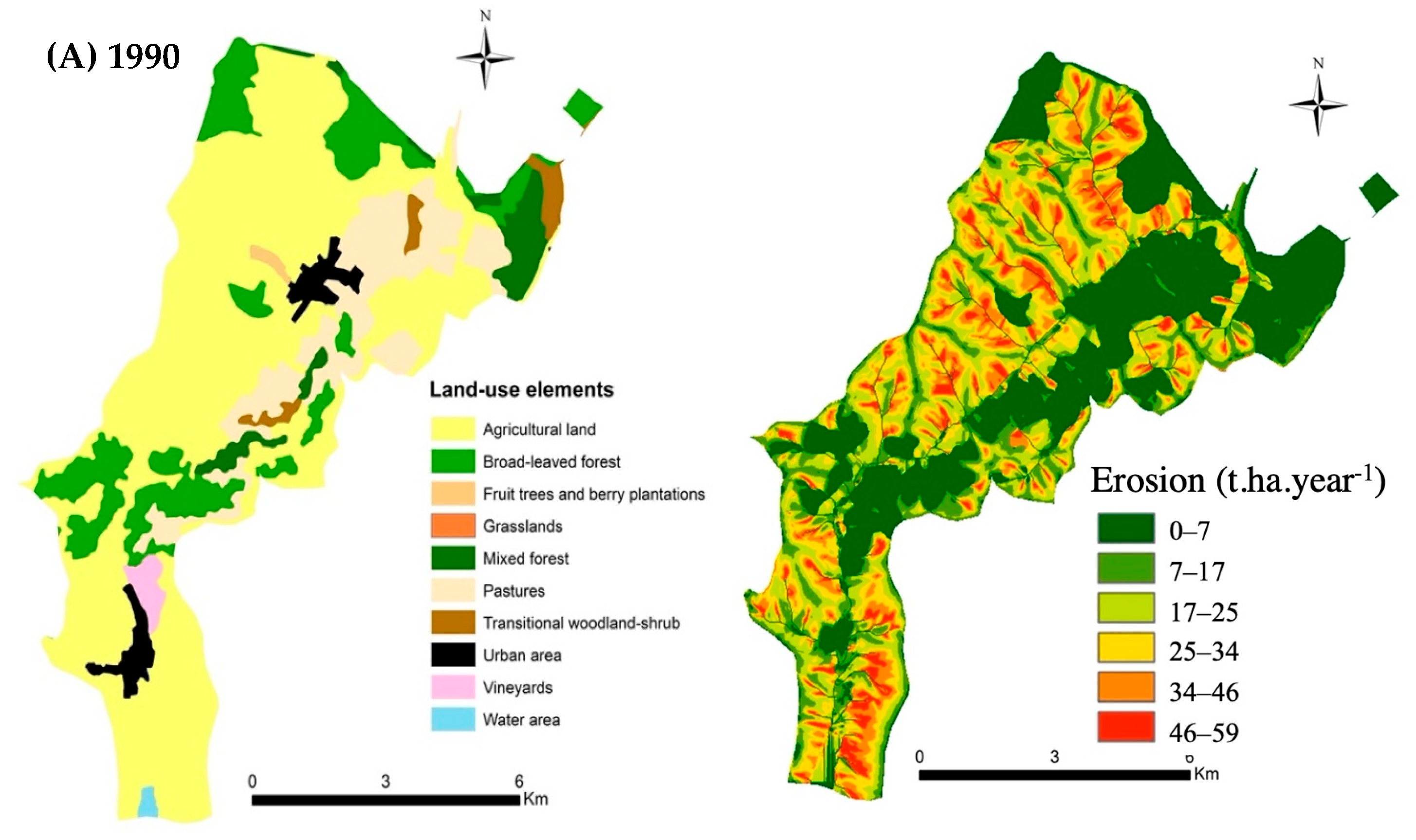

| Methods of CES Assessment by Authors | Time Period | CES (Coefficient of Ecological Stability) | Evaluation of Landscape Management According to CES | Intensity of Erosion * (t/ha/year) (EROSION-3D Model) |
|---|---|---|---|---|
| Míchal [12] | 1990 | 0.55 | Intensively used territory | 60.77 |
| 2006 | 0.63 | 65.30 | ||
| 2012 | 0.76 | 49.43 | ||
| 2018 | 0.66 | 64.71 | ||
| Miklós [13] | 1990 | 0.39 | Poor quality | 60.77 |
| 2006 | 0.42 | 65.30 | ||
| 2012 | 0.56 | 49.43 | ||
| 2018 | 0.46 | 64.71 | ||
| Kupková [14] | 1990 | 1.11 | Predominance of anthropogenic landscape elements | 60.77 |
| 2006 | 1.31 | 65.30 | ||
| 2012 | 1.52 | 49.43 | ||
| 2018 | 1.14 | 64.71 | ||
| Reháčková, Pauditšová [4] | 1990 | 1.86 | Landscape with low ecological stability | 60.77 |
| 2006 | 1.98 | 65.30 | ||
| 2012 | 2.08 | 49.43 | ||
| 2018 | 2.01 | 64.71 |
| Landscape Elements | Year | |||
|---|---|---|---|---|
| 1990 | 2006 | 2012 | 2018 | |
| Area [ha] | ||||
| Deciduous forests | 1130.33 | 1647.80 | 1704.04 | 1704.04 |
| Meadows, tall grass | 0.03 | - | - | - |
| Orchards and plantations | 27.32 | 52.87 | 52.87 | 52.87 |
| Pastures, low grass | 1009.54 | 1133.71 | 1074.18 | 1074.18 |
| Agricultural land | 4704.58 | 4109.57 | 4129.12 | 4129.12 |
| Transitional forest cover | 136.42 | 33.32 | - | - |
| Urbanized area | 225.98 | 233.13 | 226.35 | 226.35 |
| Vineyards | 81.03 | 80.46 | 98.55 | 98.55 |
| Water areas | 22.37 | 43.42 | 43.14 | 43.14 |
| Mixed forests | 312.94 | 316.25 | 322.27 | 322.27 |
Disclaimer/Publisher’s Note: The statements, opinions and data contained in all publications are solely those of the individual author(s) and contributor(s) and not of MDPI and/or the editor(s). MDPI and/or the editor(s) disclaim responsibility for any injury to people or property resulting from any ideas, methods, instructions or products referred to in the content. |
© 2024 by the authors. Licensee MDPI, Basel, Switzerland. This article is an open access article distributed under the terms and conditions of the Creative Commons Attribution (CC BY) license (https://creativecommons.org/licenses/by/4.0/).
Share and Cite
Németová, Z.; Kohnová, S.; Sabová, Z. Determining the Dependence of a Landscape’s Ecological Stability and the Intensity of Erosion during 1990–2018. Water 2024, 16, 378. https://doi.org/10.3390/w16030378
Németová Z, Kohnová S, Sabová Z. Determining the Dependence of a Landscape’s Ecological Stability and the Intensity of Erosion during 1990–2018. Water. 2024; 16(3):378. https://doi.org/10.3390/w16030378
Chicago/Turabian StyleNémetová, Zuzana, Silvia Kohnová, and Zuzana Sabová. 2024. "Determining the Dependence of a Landscape’s Ecological Stability and the Intensity of Erosion during 1990–2018" Water 16, no. 3: 378. https://doi.org/10.3390/w16030378
APA StyleNémetová, Z., Kohnová, S., & Sabová, Z. (2024). Determining the Dependence of a Landscape’s Ecological Stability and the Intensity of Erosion during 1990–2018. Water, 16(3), 378. https://doi.org/10.3390/w16030378







